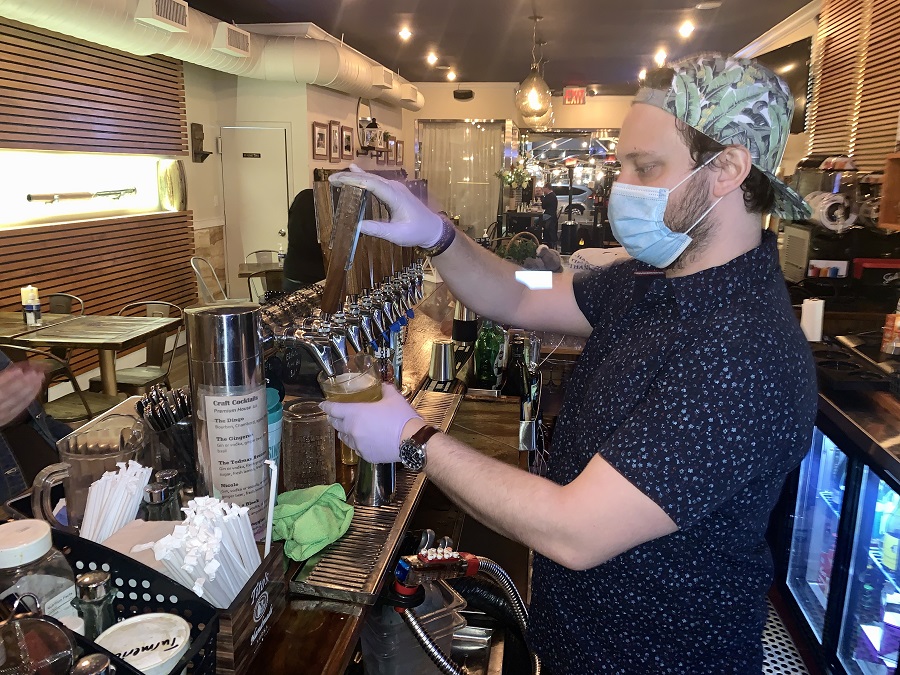COVID Cocktails: 10 Ways the Pandemic Impacted Adult Beverage Consumption 3/16/2021

Exactly one year ago at the time of this writing (March 11), life as we knew it changed. That was the date in which the World Health Organization declared the coronavirus a global pandemic. Stay-at-home orders were enacted throughout the U.S., everything started shutting down, and we all hunkered down inside our homes.
The adult beverage category was among those most impacted by the pandemic, and both on premise and off premise sellers of beer, wine and spirits have seen drastic changes to their businesses as a result. At the onset of the pandemic, bars and restaurants faced indoor gathering restrictions, which drove a ton of business to grocery stores, mass retailers and specialty stores. Bars and restaurants were able to recoup some of these consumers as the lifting of restrictions enabled them to offer cocktail delivery to complement their takeout and delivery offerings. But they still faced an uphill battle.
Both on premise and off premise purveyors of booze adapted some unique strategies to accommodate the COVID consumer, and many of these new practices will remain long after the pandemic has passed. During ECRM’s On and Off Premise Adult Beverage Program, I interviewed more than a dozen buyers from restaurants, grocery chains, convenience stores and hotels to learn how their consumers have altered their adult beverage consumption over the past year, and what their businesses have done to address these changes. Below are 10 key takeaways from these discussions.
1. Cans, Cans, Cans: RTD growth accelerates
Already a booming segment before the pandemic, canned wine and cocktails have exploded in popularity at both on-premise and off premise locations during the pandemic. At retail, they are easy for shoppers to carry and store in the fridge, and many grocers now offer a wide variety. In fact, one of the challenges is deciding which of the tons of new brands to carry on their shelves.
For on premise operators, cans are perfect for curbside pickup and delivery, and convenient for outdoor dining guests, as well, as they are easy to serve (my local spot, The Thirsty Koala, had a special during the summer of four cans of High Noon for $25, served in a bucket of ice).
Even fine dining establishments are now getting into the game. “There was absolutely no chance of us selling canned cocktails before the pandemic,” says Brian Keyes, SVP of Operations for Connor Concepts, which operates Chop House and Connors Steak & Seafood Restaurants in five states. “Now we have to take a hard look at them, as 30 percent of our business is now pickup and delivery.”

2. Premiumization gets even more premium
Another trend that was prevalent prior to the pandemic, premiumization, has also experienced a boost over the past 12 months. As consumers are eating and entertaining more at home, they are taking some of the money they have saved from not dining out and using it to buy higher-quality drinks – both from retailers as well as on-premise operators. “We’ve seen a spike in price points and depth of purchase,” says Andrew Dobbie, Category Manager - Wine & Spirits at Rouse’s Markets, which operates more than 60 food retail stores in Louisiana, Mississippi and Alabama. “They are buying more expensive brands across all segments.”
3. Bigger is better when it comes to off premise
Along with higher-ticket items, retail consumers are buying in bulk to avoid having to make multiple trips to the store, including cases of beer, wine, canned adult beverages, and 3-liter bag-in-box wines.
4. To-go cocktails
This was a big topic of my conversation with Ashley Bray of Bar Business, who also moderated a roundtable on the topic during the session (see video below). During the pandemic, many states lifted restrictions that prevented restaurants and bars from providing liquor, wine and mixed drinks to go or by delivery, and while these were originally supposed to be temporary, it has continued throughout the pandemic.
Many off premise locations found creative ways of embracing this. Restaurants started offering batch cocktails to handle the demand for takeout and delivery, and during the summer frozen cocktails were all the rage. Indeed, in New York City during the summer one could not avoid seeing several frozen drink mix machines set up at every restaurants to serve passerby, and by the evening every garbage can was filled with plastic containers. They also got creative with their marketing around this packaging, including branded stickers on the plastic cups and other packaging, and including to-go cocktail menus with deliveries.
5. Suggestive selling
To take advantage of the ability to sell to-go cocktails, restaurants have begun to incorporate suggestive selling to their order-taking processes, training their staff to recommend a cocktail as an add-on when a customer orders a meal. “This can be a bit of a challenge, because it can add a couple of minutes to an order,” says Connor Concept’s Keyes. “But it definitely helps with the margins.”
6. Party Kits for the home mixologists
This trend spans both on and off premise but has been particularly popular with off premise locations that have tied in some sort of cocktail prep education into the mix, such as live mixology lessons during virtual happy hours. Cul+ture Collective in NJ was an early adopter of these types of events, often attracting 100+ paying participants to its Saturday evening virtual happy hour and cocktail classes. (In my video interview with them last April, they discussed how they produced these events.)
Concord Hospitality Enterprises offers party kits in its markets that are popular with guests as well as locals. These kits contain everything one needs to make a specific cocktail – such as a 6-ounce bourbon, flask of bitters, oranges and a whiskey cherry to make an Old Fashioned. “We also tie in education via social media,” says Dean Wendel, VP of Food & Beverage. “We create an instructional, 30-second video clips for each one of the kits.”
7. On-premise exclusive beverages
The challenge with restaurants having to rely heavily on takeout and delivery is that consumers know they can get many adult beverage products for less cost at the local grocery, drug or wine & spirits store. To address this, many have focused on sourcing products that can’t easily be found at local retailers. “We’ve had to change what we carry,” says Danny Williamson, Director of Operations for Furious Spoon, a ramen restaurant chain based in Chicago. “We must have changed our beer list more in the last 12 months than we have in the previous five years, and only offer high-end canned cocktails. We don’t offer products that you’ll see in our local convenience or liquor stores.”

8. Ramping up curbside pickup
Many fine dining establishments that don’t offer takeout options were caught flat-footed by the pandemic and will be working in curbside pickup into their strategies in the foreseeable future. Indeed, one operator I spoke with plans to incorporate curbside pickup structures into any future new restaurant builds.
9. A serious look at ghost kitchens
With delivery becoming such a mainstay of restaurants during the pandemic, many are exploring the viability of launching ghost kitchens to leverage the available capacity of their existing kitchens, which has increased at many restaurants due to indoor dining restrictions. One operator is even considering a kind of hybrid model, in which it will open two side-by-side restaurant concepts, each with its own branding and staff, but serviced by one kitchen connected to both. A kind of half-ghost kitchen, if you will.
10. Non-booze booze continues to grow
Non-alcoholic or “zero proof” adult beverages continue to grow in popularity, and are getting much more innovative with their offerings. And they’re not just for tee-totalers, either. Many consumers are alternating alcoholic and non-alcoholic beverages as a way to keep the party going in a responsible way – without having to drink a boring glass of water in between.
Wrapping up: Blurred lines between on- and off-premise
Overall, the pandemic has really caused a blurring of lies between on and off premise as dining and entertaining moved from bars and restaurants to living rooms and backyards. While this initially gave retailers an edge in share of wallet, the on-premise folks have fought back with creative solutions around takeout and delivery options. Now as indoor dining restrictions start getting lifted across the country (here in NYC we go to 50 percent on March 19), it will be interesting to see which of these changes remain, and which fall by the wayside.
One thing’s for sure, both the on premise operators and the off premise retailers each learned some new tricks from each other, and the entire adult beverage industry will be the better for it!
ECRM's 2022 On and Off Premise Adult Beverage Program will be held March 1 to 3, 2022.
- Interested suppliers/SMB buyers contact Sarah Davidson, SVP of Food & Beverage
- Interested Tier 1 retail buyers contact Wayne Bennett, SVP of Retail
(This article was originally published in Bar Business)
Bar Business Editor-in-Chief Ashley Bray on how bars and restaurants are surviving the pandemic

